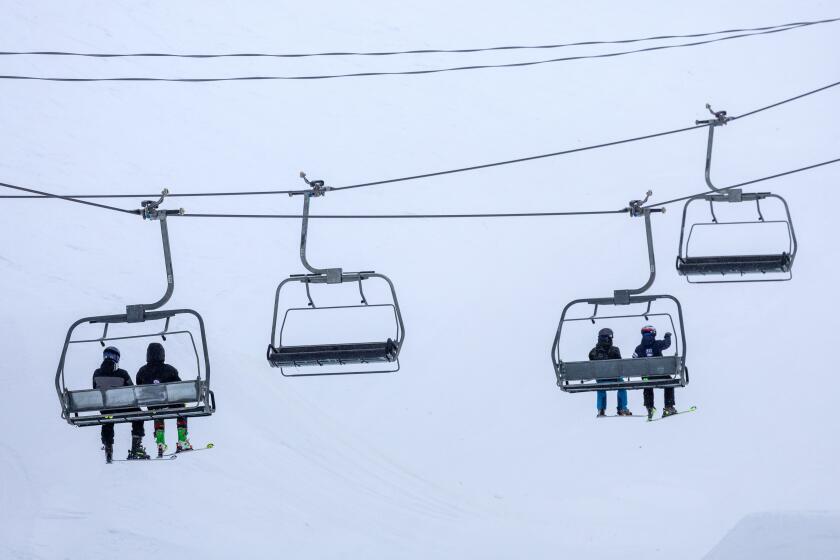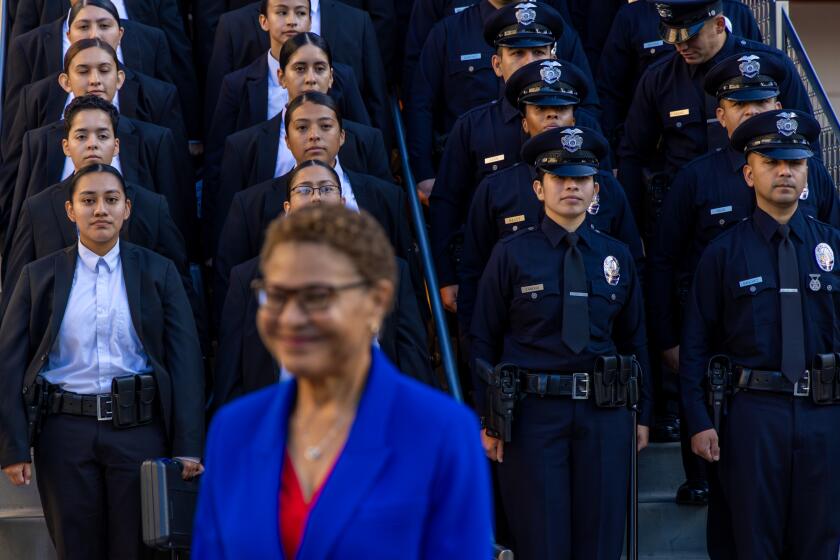Review Spreads Blame for Leaks in L.A. Subway
- Share via
Water leakage has caused millions of dollars in damage to the new Los Angeles subway because a costly protective liner was poorly designed, installed and inspected, according to consultants to the Metropolitan Transportation Authority.
The transit agency paid an extra $2 million a mile to install a special plastic liner that was supposed to keep water and explosive methane gas from penetrating the concrete tunnels and stations. But portions of the Downtown Red Line have leaked ever since construction was completed in 1992.
“Defective installation by the contractor, inadequate construction management by (the firm of Parsons-Dillingham), a deficient design . . . and even an unusually large amount of rain, all appear to have contributed to the problems,” wrote Dennis L. Veraldi, of the Pennsylvania law firm of Eckert Seamans Cherin & Mellott, a consultant to the MTA.
Those bluntly worded conclusions, contained in a letter last week to the MTA, stand in contrast to the statements of top transit officials, who have declined over the past two years to assess blame for the leaks.
The law firm said the five-page letter was prepared to help the MTA respond to Times inquiries about the leaks, which engineers say raise questions about the subway’s durability.
The ground water in some locations around the subway, particularly at Union Station, has been found to be highly corrosive. And experts warn that if the membrane is leaking, water could damage the steel-reinforcing rods in the concrete, and that methane gas could seep into the tunnels.
Transit officials have said they believe the subway is safe and sound. Representatives of the designers, builders and inspectors have all said that they properly performed their respective roles.
After a Times report that numerous segments of the tunnels were built thinner than designed, officials appointed three outside experts to assess the structural integrity of the subway. The panel also will evaluate the impact of corrosive water on the tunnels.
During the week before the panel arrived, leaks between Union Station and Pershing Square were grouted for what transit officials said were cosmetic reasons.
Leaks have been a longtime concern on the $1.45-billion project. The Pittsburgh-based law firm was retained last year, when the MTA was considering filing an insurance claim for the leaks against the policy of the subway’s private sector designers, Metro Rail Transit Consultants.
For now, the transit agency has decided not to seek remuneration from the design team, the construction contractors or the inspection firm of Parsons-Dillingham.
The agency is not pursuing those parties, said subway project manager Charles W. Stark, because it is “impossible to determine exactly where the water is coming from and whose responsibility it might have been.”
Instead, Stark said, the agency will soon submit a $6.8-million claim against its own “builder’s risk” insurance policy. The policy covers leak-related expenses incurred during construction and before Feb. 1, 1992.
The law firm’s letter of Oct. 11 identified several causes of the leak problems. Citing reports and extensive inspections performed on behalf of the transit agency, the letter detailed the following:
* The design to control water leaks was “fatally flawed,” according to a January, 1992, consulting report by Fluor Daniel Inc.
Martin Rubin, director of the subway design team and an executive of Parsons, Brinckerhoff Quade & Douglas Inc., did not return calls Friday seeking comment.
Two of Rubin’s engineers blamed factors other than design in an April, 1991, report obtained by The Times. “In all cases,” wrote the engineers, “the leakage into the structure appears to be the result of the compromising of the (membrane) during or after construction. This . . . causes water to infiltrate the structure and will, in time, cause deterioration of the structure. More importantly the presence of water behind the (membrane) raises questions . . . regarding gas migrating into the tunnel system.”
* Parsons-Dillingham, the firm that was paid more than $150 million to oversee construction of the subway’s first segment, did not adequately inspect the tunnel liner installation, the Fluor Daniel report concluded. A spokesman for Parsons-Dillingham declined to comment.
* To save money, transit agency officials in 1986 altered the design of the tunnels and stations to eliminate “water stops” that could have limited the spread of water leaks. The decision was based on an assumption that the plastic membrane alone would keep the structures dry.
* There was “considerable evidence” of defective installation by construction contractors, according to a review by the MTA’s rail construction staff. John Sohn, the staff member who headed the review, told the law firm that “most or all of the water leaks resulted from installation errors by the contractors and could have been prevented by better quality control on their parts.”
Sohn, who has overseen repairs of many of the leaks, could not be reached for comment.
Representatives of construction companies, which have clashed with the transit agency over the water damage issue, said they were unaware of the conclusions detailed in last week’s letter.
Michael Lawson, a spokesman for Granite Construction Co., builder of the leak-plagued subway station at 7th and Flower streets, said the company performed properly.
“We installed the membrane per contract documents,” Lawson said. “The inspection of our installation was done (by Parsons-Dillingham). Any deficiencies were noted and repaired at that time.”
The MTA is seeking millions of dollars in back charges from Granite for water damage repairs at the station.
Another contractor, Ronald N. Tutor, whose company built tunnels and portions of four subway stations that opened to the public in January, has said that he believes the system’s design is faulty. As for the work of his company, Tutor-Saliba Corp., Tutor said:
“Not only did we install (the membrane) properly, but we kept a quality control person on staff, full time, to inspect it.”
Over the past two years, Tutor-Saliba and another contractor, Morrison-Knudsen, have received about $3.1 million to repair leaks at locations throughout the stations and tunnels. Any of those costs incurred before February, 1992, would be among those that the MTA hopes to recoup through the $6.8-million insurance claim.
Numerous transit commissioners have complained about the leaks and the costs of repairing them. Nikolas Patsaouras, an appointee of county Supervisor Mike Antonovich, has urged rail construction staff over the last two years to seek remuneration, through back charges, lawsuits or insurance claims, from those responsible for the leaks.
“The staff has been giving me the runaround,” Patsaouras said. “We have designers who have no accountability. There is no incentive to do correct (construction) work. . . . I have been harping on this for years, and no one has responded.”
In an interview in June, the MTA’s rail construction president, Edward McSpedon, said he would be reluctant to pursue an insurance claim against the designers or Parsons-Dillingham. “People will do a professional job, but it’s never going to be perfect,” he said.
The law firm’s letter last week, written to an aide to project manager Stark, endorsed the MTA staff’s decision to delay or avoid filing a claim against the designers’ insurance policy, pending resolution of the separate $6.8-million claim.
“A satisfactory result is more likely with this approach,” the letter states, “given the nature of the water leaks, the parties involved, the continuing relationship with (the team of major design firms) and the overall status of the project.”
Edwin Van Zijll, vice president of Allianz Insurance Co., said he could not comment on how the German-based company views the MTA’s planned claim.
Stark said he expected that the claim would be submitted before the end of the year.
Abdoul R. Sesay, insurance risk manager for the MTA, said the claim was complex and that the agency does not know “exactly what deductible will apply.” He estimated that it could be from $25,000 to $1 million.
Sesay said he was not at liberty to discuss the cost of the insurance because it might undermine the MTA’s efforts to seek competitively priced rates.
“We are protecting the interest of the public in trying to collect the money on behalf of the taxpayer,” he said.
Times research librarian Julia Franco contributed to this story.
More to Read
Sign up for Essential California
The most important California stories and recommendations in your inbox every morning.
You may occasionally receive promotional content from the Los Angeles Times.











